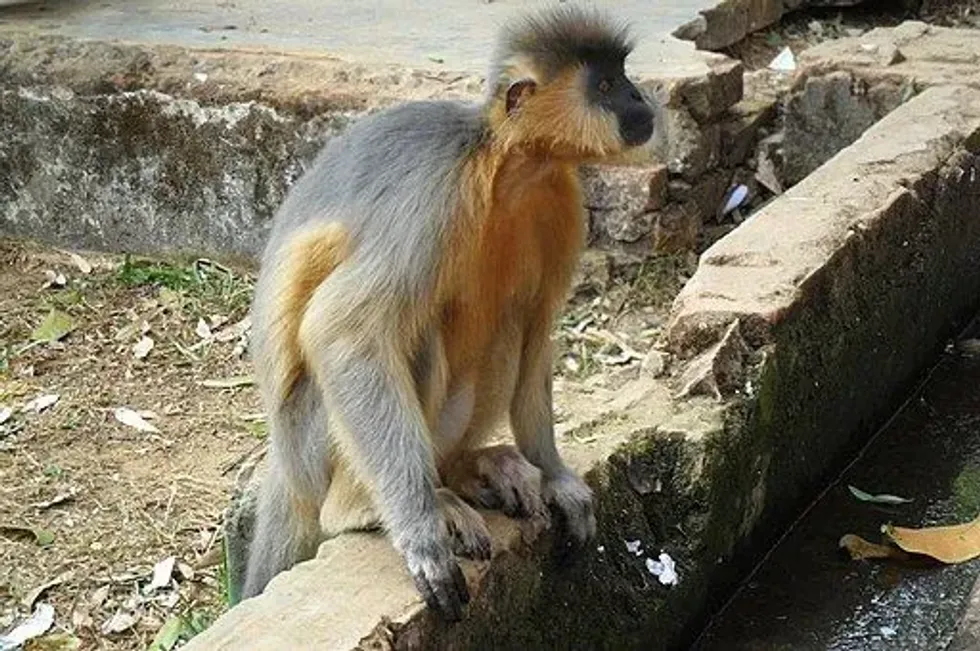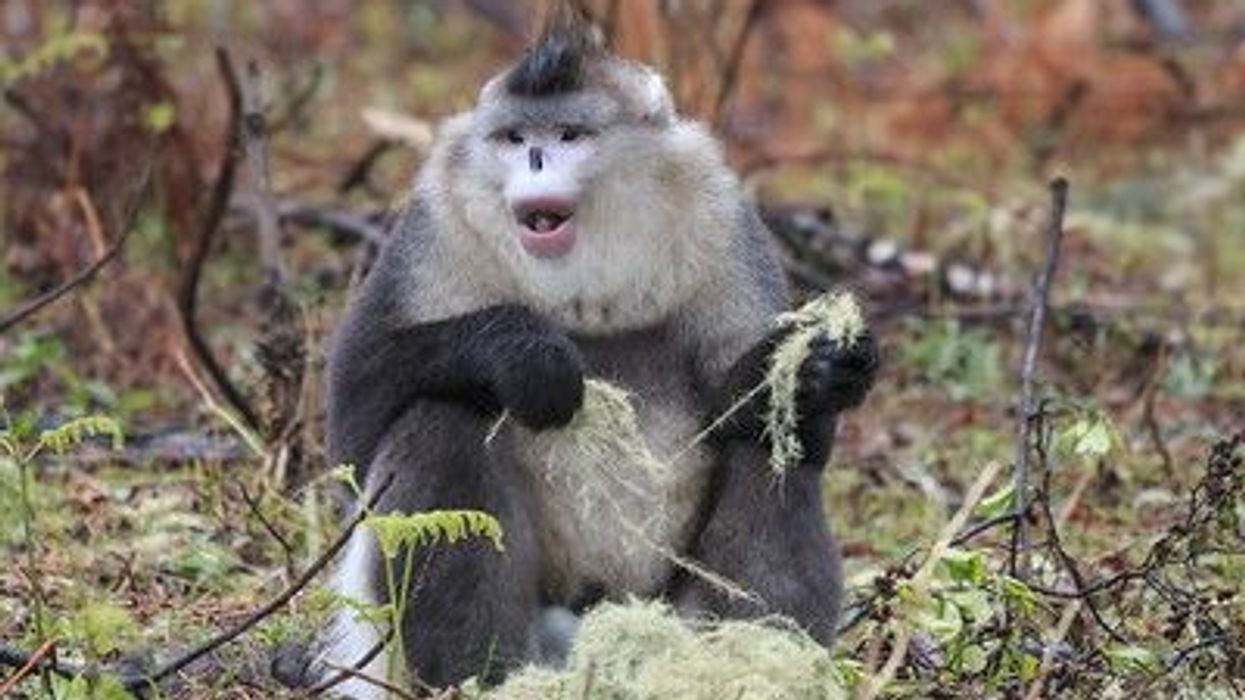Monkeys jumping from one tree to other or hanging on branches are extremely admirable sights to behold. One of these is the capped langurs, a primate species of animals.
You must be wondering why they are called capped langurs? It is because of the dark-colored hairs atop its head as it appears to be a cap of the head of the langur.
It is said to be arboreal. Its population range from Northeast India including the states of Assam, Arunachal Pradesh, Nagaland to the bordering countries of Bhutan, Bangladesh, Myanmar, and the bordering areas of China.
A capped langur, Trachypithecus pileatus, is a species of primates found in forests. It is reported to have four subspecies, Trachypithecus pileatus pileatus, Trachypithecus pileatus durga, Trachypithecus pileatus brahma, Trachypithecus pileatus tenebricus.
The species is recorded to be Vulnerable under the IUCN Red List of Threatened Species, as the population is facing an arbitrary decline due to habitat loss primarily caused by Jhum cultivation, deforestation, and other developments. Also, it faces threats from its predators, majorly leopards and hunting carried out by human populations.
If the uniqueness of capped langur makes you interested to read more about similar species, you can read about these woolly monkey facts and bush baby facts.
Capped Langur Interesting Facts
What type of animal is a capped langur?
The capped langur, Trachypithecus pileatus, falls under the species of primates belonging to the genus Trachypithecus. The langur is said to have primarily four subspecies recorded as Trachypithecus pileatus pileatus, Trachypithecus pileatus durga, Trachypithecus pileatus brahma, and Trachypithecus pileatus tenebricus.
What class of animal does a capped langur belong to?
The capped langurs, specifically belonging to the group of primates, belong to the class Mammalia.
How many capped langurs are there in the world?
Capped langurs are primates majorly located in Assam. There is no data computing the population size of the species. The population of the species is recorded to be Vulnerable under the IUCN Red List of Threatened Species.
Where does a capped langur live?
Populations of the capped langurs are found in Northeast India, Bhutan, Myanmar, Bangladesh, and bordering areas of China. It is mainly found in Assam, Nagaland, Arunachal Pradesh, Tripura, and other northeastern states of India.
Further, it extends to Bhutan, Bangladesh, west of Myanmar, Tibet, and the confined region of China. It is also reserved in many protected areas such as national parks, considering the destruction of its geographic habitat, especially trees.
What is a capped langur's habitat?
The natural geographic habitat of the capped langurs ranges from tropical wet and dry green lands to deciduous and temperate forests. Precisely, capped langur habitat is subtropical or tropical dry forests.
They are reported to be arboreal, living on trees up high above the forest floor. Their natural habitat is recorded to face a range of destruction activities like Jhum cultivation, deforestation, and other developments.
Who do capped langurs live with?
The species of primates residing in the forest, capped langurs, are gregarious in nature. Thus, are commonly found to live in groups comprising of seven to nine individuals.
The group is led by an adult male. Langurs are also recorded to live solitarily or in multi-male or multi-female groups led by adult males and adult females, respectively. Moreover, they sleep solitarily on a tree except for females who have infants to look after.
How long does a capped langur live?
According to the search done, capped langurs live up to 25 years on average in the wild forests. But according to the IUCN, there occurs a decline in the average life span of the species due to habitat loss, hunting, or predators such as leopards.
How do they reproduce?
The breeding season of these primate animals is recorded to range from September to January. Their gestation period is recorded up to 200 days. Females give birth to an individual at a time. Females are reported to live the initial two months after the birth of infants alone, while the rest are in the groups with other females.
What is their conservation status?
The IUCN Red List of Threatened Species reports the capped langurs, primate animals found in forests, to be Vulnerable. The species occurs to face threat due to various range of reasons such as habitat loss, hunting, and other development activities carried by the human population.
Capped Langur Fun Facts
What do capped langurs look like?
Capped langurs have dark hairs atop their head with black faces and long tails. The ears, hands, feet of the animal are black in color. The fur on the belly and back is buff or orange-colored.
The hind part of their bodies is light blue in color. Hind part of males is brighter than females. The length of the tail ranges from 37-41 in (94-104 cm).
How cute are they?
Being gregarious in nature, the species of arboreal langurs are adorable. Capped langurs jumping and hopping around the branches of the trees in the forest are a pleasure to see. The population found in group, grooming and hugging each other playfully is another cutest thing to sight.
How do they communicate?
The populations of the monkey, the species of primates, communicate through growls, barks, and calls that sound like 'eeeeeh'. They use different vocalizations depending on the situation.
How big is a capped langur?
Capped langurs are 19.6-27.5 in (50-70 cm) long, approximately. While the body length of males varies within 23.6-27.5 in (60-70 cm), females are comparatively shorter with about a length of 19.6-25.5 in (50-65 cm). The tail is recorded to be three times the body length. In comparison, gorillas are thrice their size.
How fast can a capped langur move?
While mostly, the primates use their arms to swing around the branches of trees in the forest, the capped langurs use their four limbs to move from one tree to other. The group is recorded to move around 1476 ft (450 m) a day.
While the patas monkey is recorded to be the fastest among the species of primates, the speed of the capped langurs is yet to be deciphered.
How much does a capped langur weigh?
The male is heavier than a female. While a male weighs around 24-31 lb (11-14 kg), a female is recorded to weigh 21-25 lb (9.5-11.3 kg). Comparing the capped langur size, capped langur weight, and mass, the eastern gorilla is recorded to be the largest living primate.
What are the male and female names of the species?
There is no sex-specific name assigned to the species. It can be called a capped langur male or a capped langur female, respectively.
What would you call a baby-capped langur?
There is no separate name for the baby-capped langurs. They can be called infants for the initial years of its life.
What do they eat?
Capped langurs are herbivores, more specifically folivores. Leaves add up to half of the capped langur diet, while fruits and flowers make up a quarter of their diet.
Feeding a leaf and digesting it is hard; the monkeys have multi-chambered stomachs with enzymes helping with the breakdown of the food. The rest of the diet consists of food items like seeds, twigs, and bugs. Secondarily, their food at rare times includes insects residing in the forest to cope up with their feeding habits.
Are they dangerous?
This group of monkeys, living on trees and residing in a reserved geographic area, is not recorded to possess any danger.
Would they make a good pet?
Capped langurs are wild animals preferred to stay in groups on the tree in their natural geographic habitat. They do not make an ideal pet. Considering the vulnerability faced by the species, they are kept reserved in the national parks of India (especially in Assam, Nagaland, Arunachal Pradesh, and Tripura), and other countries.
Did you know...
The population of capped langurs faced a 30% decline due to the destruction of their geographic habitat and is considered a Vulnerable species.
It is one of the langurs recorded in the state of Assam in India.
It is arboreal and gregarious in nature. While it prefers to stay in a group of seven to nine individuals led by males, it sleeps alone on a tree.
A hybrid of capped langur (monkeys, India) and pig-tailed macaque, capped langur-pig tailed macaque hybrid, is recorded in the Assam region of India and Bhutan.
A capped langur is also known as Trachypithecus pileatus.
A capped langur is found in various national parks of Northeast India including Nameri National Park, Kaziranga National Park, Manas National Park, and many other national parks and wildlife sanctuaries.
Why are langurs considered sacred?
Langurs are considered sacred and are worshipped under the Hindu religious system, especially in Assam. This is because of their resemblance with Lord Hanuman, who burned his hand and face to rescue a woman from a fire.
It is also said that the act of Lord Hanuman justifies the black color of the hands and face. They are kept during religious acts and performances by Hindu priests.
Species of langurs also hold religious importance as they are used in medicines and as food. In recent times, these monkeys tend to lose their sacred importance.
Are capped langurs Endangered?
Yes, they are reported to be Vulnerable as are facing various threats, majorly habitat destruction. It is reported that the entire population of the species was eliminated from a forest of Assam due to forest destruction.
To reserve the species, they are being monitored, laws are passed to force restriction over their hunt, and measures are being taken to preserve the forests and limit deforestation.
Here at Kidadl, we have carefully created lots of interesting family-friendly animal facts for everyone to discover! For more relatable content, check out these baboon facts and vervet monkey facts pages.
You can even occupy yourself at home by coloring in one of our free printable Capped Langur coloring pages.










